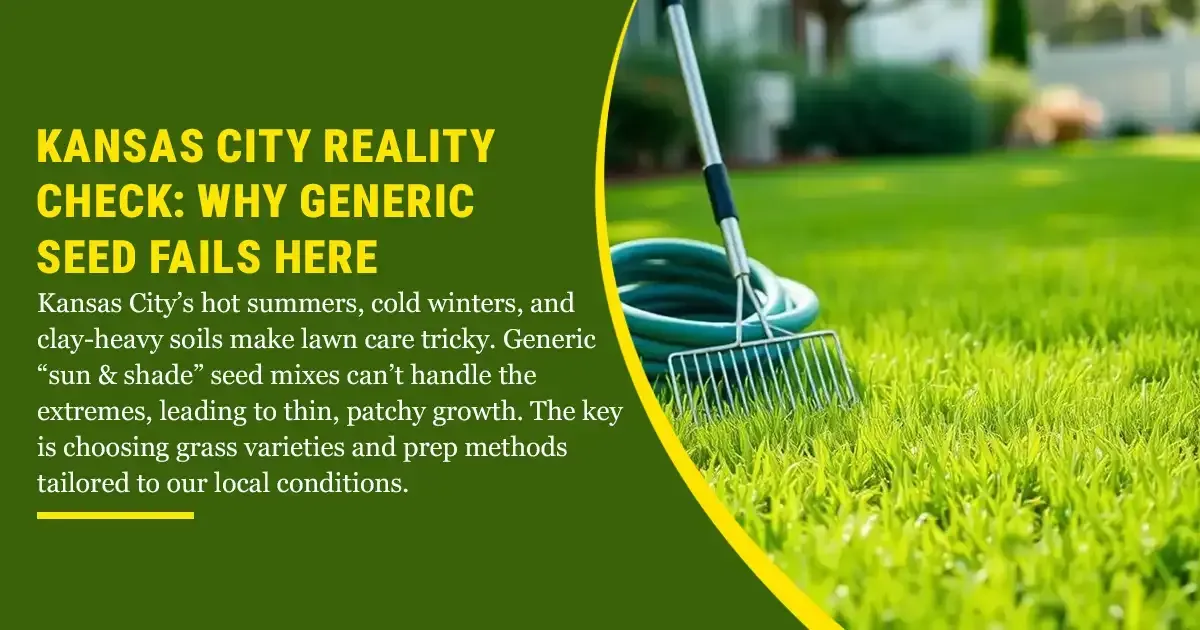Kansas City’s Turf Emergency: Why 2025’s Drought Is Threatening Lawns—and What You Can Do
Kansas City is facing one of its toughest summers in recent memory. After months of low rainfall and record heat, lawns across the metro are showing serious signs of stress — patchy grass, bare spots, and stubborn weeds that thrive in dry soil. For homeowners who take pride in their curb appeal, the 2025 drought is more than an eyesore. It’s a battle to keep their lawns alive.
Experts warn that without proactive care, the combination of heat, drought, and compacted clay soil could leave yards vulnerable for years to come. But there is good news: with a strategic approach and the right lawn care program, Kansas City homeowners can fight back against the drought and protect their investment in their property.
At
Lawnscape Specialists, we’ve been helping Kansas City families navigate lawn challenges for years. Here’s what the 2025 drought means for your turf — and the proven strategies that will keep your lawn resilient even in extreme conditions.
Why This Year’s Drought Is Different
Missouri weather has always been unpredictable, but 2025 has delivered a punishing one-two punch. The spring brought less-than-average rainfall, followed by weeks of soaring summer temperatures. The result? Soil that dries out quickly, making it nearly impossible for grass roots to retain moisture. In neighborhoods from Brookside to the Northland, homeowners are noticing lawns turning brown earlier than usual.
“The combination of clay-heavy soil and intense heat makes Kansas City lawns especially vulnerable,” notes one local agronomist. Unlike sandy soils that drain quickly, clay holds water poorly once compacted. This creates a cycle of shallow roots, weak turf, and ideal conditions for weeds and pests.
The Hidden Costs of Drought Stress
A brown lawn isn’t just unattractive — it can also create long-term problems. Drought-stressed turf struggles to recover, leaving thin patches where invasive weeds like crabgrass and foxtail quickly move in. Even worse, the weakened grass attracts pests like chinch bugs, grubs, and moles searching for food sources under the soil.
Once these issues take hold, restoring your lawn becomes far more costly and time-consuming. That’s why prevention and proactive care are key during dry years like 2025.
How Kansas City Homeowners Can Respond
1. Fertilize Strategically
Random fertilizer applications can do more harm than good in drought conditions. That’s why programs like our
6-Step Lawn Care Program are designed around Kansas City’s seasonal challenges. With timed fertilization and weed control, your lawn gets exactly what it needs, when it needs it — no guesswork required.
2. Aerate to Relieve Soil Compaction
Drought makes Kansas City’s clay soils hard as concrete. Aeration breaks up the compaction, allowing water, nutrients, and oxygen to reach the roots. Pairing aeration with overseeding in the fall is one of the most effective ways to restore stressed lawns and encourage thicker turf next spring.
3. Control Weeds Aggressively
Weeds thrive when turf is weak. Left unchecked, they can quickly dominate dry, patchy lawns. Professional weed control, combined with overseeding, ensures your yard stays green and uniform instead of turning into a weed patch.
4. Adjust Watering Practices
Watering is essential, but how you water matters. Short, frequent watering encourages shallow roots. Longer, less frequent sessions — ideally in the early morning — encourage deeper, stronger roots. Our team advises clients on watering schedules tailored to Kansas City’s climate and water restrictions.
5. Defend Against Pests
Insects and small animals are drawn to weakened lawns. Services like
Pest Control protect against mosquitoes, moles, grubs, and other common invaders. Preventative treatments stop problems before they become infestations that damage both turf and landscaping beds.
The Landscaping Factor
Lawn health isn’t just about grass. Properly maintained landscaping beds play a big role in creating a drought-resistant yard. Mulch helps soil retain moisture, while thoughtful
landscaping services — including shrub planting, hedge trimming, and flower installation — keep your outdoor space vibrant, even when your lawn is under stress.
Rock installation and hardscaping projects can also reduce turf coverage in areas that are difficult to maintain, creating a balance between beauty and practicality during dry years.
Looking Ahead: Preparing for Fall Recovery
The worst of summer may be tough, but fall is the season of recovery. Overseeding and fertilization in cooler weather give your lawn a second chance to thrive. Paired with aeration, these steps ensure new grass can establish strong roots before winter. By acting now, homeowners can avoid carrying this year’s drought damage into 2026.
What Kansas City Homeowners Should Do Now
The Kansas City turf emergency isn’t going away overnight. But with a clear plan and professional guidance, your lawn can weather the storm. Choosing the right treatments now will save you time, money, and stress in the long run.
At
Lawnscape Specialists, we’ve built our reputation on helping Kansas City homeowners tackle the region’s toughest lawn and pest challenges. From fertilization programs to pest defense, aeration, and landscaping, we provide the tools and expertise your lawn needs to stay resilient.
Final Word
2025’s drought may be tough on Kansas City lawns, but it doesn’t have to mean the end of your curb appeal. By taking action now — fertilizing strategically, aerating soil, controlling weeds, and defending against pests — you can protect your investment and enjoy a healthy, vibrant yard again.
Don’t let the drought win. Contact Lawnscape Specialists today to build a recovery plan tailored to your lawn and keep your turf strong in 2025 and beyond.










